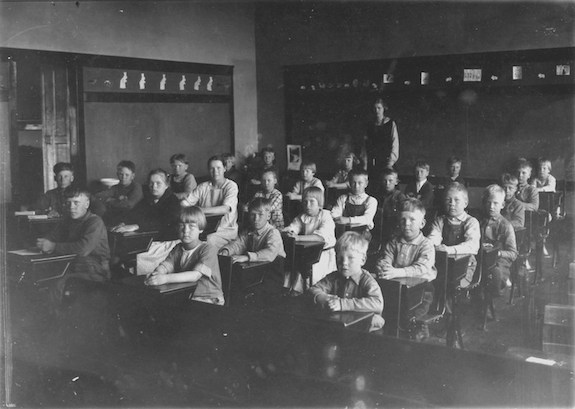
In a 2013 interview with the NY Times, Laszlo Bock, senior operations VP at Google, reported that the company now bases its hiring on candidates’ thinking ability rather than their academic credentials. The reason? Company research revealed that college Grade Point Averages (GPAs) and test scores are “worthless” and that in some cases people who have never attended college outperform graduates.
Similar reports made headlines in the 1980s. At that time the Carnegie Foundation estimated that big business was spending up to $100 billion a year in corporate classrooms to develop thinking and other fundamental skills the schools had failed to teach. In response to the report, business, professional, and educational organizations called for a major initiative to emphasize thinking in all classrooms.
The organizations included the New York State Regents, the National Council of Teachers of English, The Presidential Commission on Excellence in Education, the College Board, the University/Urban Schools National Task Force, the Carnegie Foundation for the Advancement of Teaching, the Exxon Education Foundation, the American Federation of Teachers, the Association of American Colleges, the National Institute of Education, the U.S. Department of Education, the Association of Superintendents and Curriculum Developers, and the National Endowment for the Humanities.
Although many individual teachers and professors responded by emphasizing thinking in their classrooms, few such changes occurred at the institutional level, where they were especially needed. Most teachers continued to practice what I described at the time as mindstuffing—telling students what to think instead of teaching them how to think.
In Laszlo Bock’s interview, he noted the frustration he experienced with exactly that kind of teaching in college and graduate school, and he contrasted that “artificial” situation with real-life ones in which the answers aren’t so obvious and have to be worked out.
The situation in schools and colleges remains essentially the same today as Bock encountered and as existed in previous decades. As a pioneer in the movement to make thinking instruction central to education, I have been particularly interested in why the movement has not been more successful even though the case for thinking instruction had been persuasively made and vocally supported by leaders in the professional and business communities.
The reason is that early in the 20th century the goals and methods of modern education were established on three false premises: that thinking ability is inborn, that most people have little or no aptitude for it, and that the most appropriate learning for the masses consists of remembering information and recalling it on examinations.
Those false premises were immediately adopted as guiding principles of teacher training, textbook writing, and test design. Thus for the last century education has been conducted in a manner that not only neglects but also opposes genuine cognitive development. Students’ minds have been regarded as information warehouses rather than as workshops for producing solutions to problems, insights into complex realities, and thoughtful decisions.
Let me be more specific about the impact of those false premises on teaching and learning and the steps necessary to reverse that impact.
Modern textbooks are almost encyclopedic in their presentation of information. Every question that could be asked about the subject is answered even before students considering asking it.
In a course that emphasized thinking, textbooks would contain only the information needed to set up questions for students. A typical assignment would involve using a search engine like Google to investigate further, compare and evaluate different accounts and interpretations, and draw logical conclusions. The process of academic learning would thus become dynamic and experiential.
In the typical classroom, the teacher lectures on the same material the students were assigned to read in preparation for class. The lecture usually consists of more or less repeating what the textbook said, sometimes using different words but often simply reading aloud from the textbook.
In a course that emphasized thinking, the teacher would not lecture but instead lead students in discussing their investigations and comparing their findings. Where students’ conclusions differed from one another, the teacher would lead the class in evaluating them and deciding which line of reasoning was more in keeping with the evidence. Where flaws in thinking were involved, the teacher would guide students in identifying and correcting them.
Tests have become almost exclusively “objective,” consisting of true/false, multiple-choice, or fill-in questions, each having a single correct answer. The process by which students arrive at their answers is not measured, so the reward for guessing right is the same as for thinking carefully about the substance of the question. (Where essay questions are used, verbosity can easily hide ignorance.)
In a course that emphasized thinking, objective questions would be constructed to reveal students’ mental processes and to reward thoughtfulness. Students would not just choose “true” or “false”—they would be required to give a brief explanation of each choice. Similarly, in answering multiple-choice questions, students would not only choose an answer but also give a brief explanation of why it was preferable to the other possibilities. Where essays were used, tight word limits would be specified to force conciseness. These changes in test design would enable teachers to evaluate not just answers, but the quality of the thinking that led to them, and to use that knowledge to make instruction more effective.
All three reforms would require considerable time, effort, and money. Existing textbooks would have to be scrapped and textbook designers would have to employ a different kind of creative thinking than they are accustomed to using. Most teachers, having been taught by lecture, would need first to improve their own thinking, and then become proficient in an entirely new teaching methodology. Finally, the testing industry would have to develop a scoring system that involves human judgment and thus cannot be handled entirely by machines.
The difficulty of meeting such challenges explains why most educators, particularly administrators, have done nothing but revise their mission statements to claim that their programs promote sound reasoning, critical thinking, and problem solving. Of course,claiming to teach thinking is hardly the same as doing it. Thinking is essentially a skill that is achieved through continuing, guided practice. Talking about it or even demonstrating it is no substitute.
Imagine a basketball coach who offered his team no shooting practice, no drills, and no scrimmages but instead had them sit in the bleachers while he regaled them with stories of great moments in basketball or demonstrated his own dribbling and shooting prowess.
Or imagine a driver education instructor who spent every class driving around town and talking about skillful driving but never allowed the students to get behind the wheel. Or a piano instructor who treated students to performances of her playing ability but never let them touch the keys.
Would such teaching develop skills in students? Of course not. Neither does telling students what to think teach them how to think. And for precisely the same reason. The fact that several generations have ignored this transparent truth is a national disgrace that shows no sign of abating.
To see more of this author’s work, visit www.mind-at-work.com








